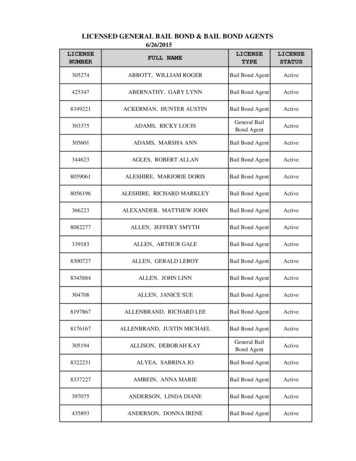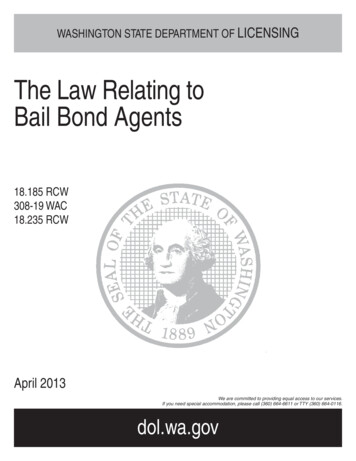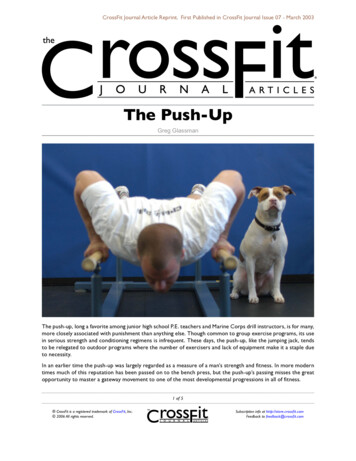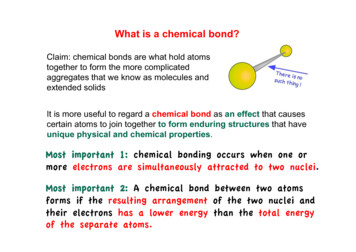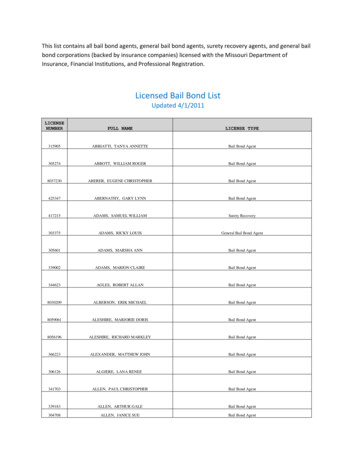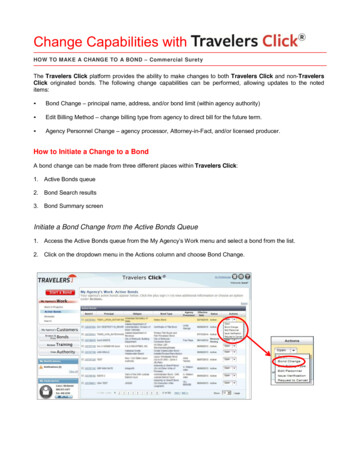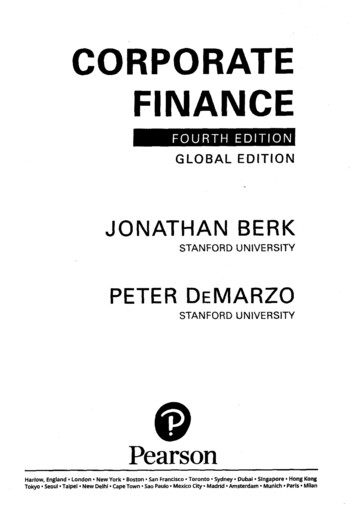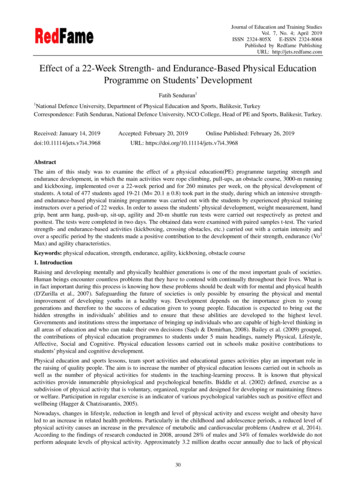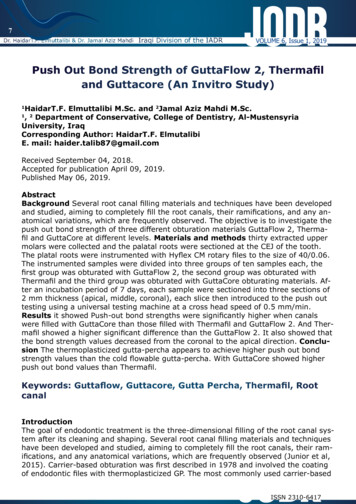
Transcription
7Dr. HaidarT.F. Elmuttalibi & Dr. Jamal Aziz MahdiIraqi Division of the IADRVOLUME 6, Issue 1, 2019Push Out Bond Strength of GuttaFlow 2, Thermafiland Guttacore (An Invitro Study)HaidarT.F. Elmuttalibi M.Sc. and 2Jamal Aziz Mahdi M.Sc., 2 Department of Conservative, College of Dentistry, Al-MustensyriaUniversity, IraqCorresponding Author: HaidarT.F. ElmutalibiE. mail: haider.talib87@gmail.com11Received September 04, 2018.Accepted for publication April 09, 2019.Published May 06, 2019.AbstractBackground Several root canal filling materials and techniques have been developedand studied, aiming to completely fill the root canals, their ramifications, and any anatomical variations, which are frequently observed. The objective is to investigate thepush out bond strength of three different obturation materials GuttaFlow 2, Thermafil and GuttaCore at different levels. Materials and methods thirty extracted uppermolars were collected and the palatal roots were sectioned at the CEJ of the tooth.The platal roots were instrumented with Hyflex CM rotary files to the size of 40/0.06.The instrumented samples were divided into three groups of ten samples each, thefirst group was obturated with GuttaFlow 2, the second group was obturated withThermafil and the third group was obturated with GuttaCore obturating materials. After an incubation period of 7 days, each sample were sectioned into three sections of2 mm thickness (apical, middle, coronal), each slice then introduced to the push outtesting using a universal testing machine at a cross head speed of 0.5 mm/min.Results it showed Push-out bond strengths were significantly higher when canalswere filled with GuttaCore than those filled with Thermafil and GuttaFlow 2. And Thermafil showed a higher significant difference than the GuttaFlow 2. It also showed thatthe bond strength values decreased from the coronal to the apical direction. Conclusion The thermoplasticized gutta-percha appears to achieve higher push out bondstrength values than the cold flowable gutta-percha. With GuttaCore showed higherpush out bond values than Thermafil.Keywords: Guttaflow, Guttacore, Gutta Percha, Thermafil, RootcanalIntroductionThe goal of endodontic treatment is the three-dimensional filling of the root canal system after its cleaning and shaping. Several root canal filling materials and techniqueshave been developed and studied, aiming to completely fill the root canals, their ramifications, and any anatomical variations, which are frequently observed (Junior et al,2015). Carrier-based obturation was first described in 1978 and involved the coatingof endodontic files with thermoplasticized GP. The most commonly used carrier-basedISSN 2310-6417
8Dr. HaidarT.F. Elmuttalibi & Dr. Jamal Aziz MahdiIraqi Division of the IADRVOLUME 6, Issue 1, 2019obturation technique is likely Thermafil. The manufacturer of Thermafil (DENTSPLYTulsa Dental Specialties) introduced a new carrier-based thermoplasticized gutta percha obturation material in 2010, which they called GuttaCore. The main difference between the Thermafil obturator and the GuttaCore obturator is the material from whichthe carrier is manufactured: the Thermafil carriers are made from plastics, and theGuttaCore carrier is made from a proprietary cross-linked gutta percha (Schroeder,2014). The advantage of this technique is the use of a carrier to compact thermoplasticized GP and sealer both laterally and vertically more rapidly than other techniques(Hale et al, 2012). In 2012, Coltène/Whaledent Inc. introduced a cold, flowable, selfcuring filling material for root canals that combine gutta-percha and sealer into oneinjectable system (GuttaFlow 2). The sealer contains gutta-percha in particle formcombined with a polydimethylsiloxane- based sealer (www.coltene.com). Adhesionof root canal filling material to dentinal walls is important in both static and dynamicsituations. In a static situation, it should eliminate any space that allows the percolation of fluids between the filling and the wall. In a dynamic situation, it is needed toresist dislodgement of the filling during subsequent manipulation; Bond-strength testing has become a popular method for determining the effectiveness of adhesion between endodontic materials and tooth structure (Amara et al, 2012). Currently, microtensile bond strength test methods are commonly used to measure the bond strengthof numerous dental materials (Armstrong et al, 2010). Unfortunately, the tensilebond strength test method is not appropriate for use with intracanal filling materialsbecause of the high percentage of premature bond failures and the large variation intest results (Soares et al, 2008). A push-out test modified from the shear punch testhas been advocated as a more suitable test for evaluating the bond strengths of intracanal filling materials (Goracci et al, 2004).Materials and MethodsThirty freshly extracted maxillary molars teeth with straight palatal root selected fromdifferent health centers for this study according to specific criteria. The age (18-45years) while the gender, pulpal status and reason for extraction were not consideredand criteria for teeth selection included the following: straight root canal and roundin cross section, mature, centrally located and patent apical foramen, roots devoid ofany resorptions, initial size of #15 hand k-file, and most important the roots shouldbe a 10 mm in length (Naser and Al-Zaka, 2013). Using a diamond disc with straighthand-piece and water coolant, the palatal root of each tooth was sectioned perpendicular to the long axis of the root at the CEJ area to facilitate straight line accessfor canal instrumentation and filling procedure (Garcia et al, 2014). The pulpal tissuewas removed by using barbed broach, then a size 10 k-file was used to ensure apicalpatency, Also the size 10 k-file was used to determine the exact location of the apicalforamen by advancing the file into the canal until it was visualized at the apical foramen by surgical loups 2.5 x magnifications. The correct working length is establishedby subtracting 1 mm. from this measurement (Naser and Al-Zaka, 2013). The rootsheld with a Silicon rubber base (heavy-body), to facilitate handling of the roots during instrumentation and obturation technique (Al- Ani and Al-Huwaizi, 2011). Beforestarting the instrumentation a size 15 k-file was used to obtain a glide path, the filewas introduced to the full working length then a small stroke was used, to confirmthat a reproducible glide path is present; the size 15 file was taken to full workingISSN 2310-6417
9Dr. HaidarT.F. Elmuttalibi & Dr. Jamal Aziz MahdiIraqi Division of the IADRVOLUME 6, Issue 1, 2019length. The file was then withdrawn 1 mm and should be able to slide back to working length by using light finger pressure. Thereafter, the file is withdrawn 2 mm andshould be able to slide back to working length, using the same protocol. When thefile can be withdrawn 4 mm to 5 mm and slide back to working length, a reproducible glide path was confirmed (Van der Vyver and Scianamblo, 2014). The canals wasprepared with crown down technique using Hyflex system (Coltene/Whaledent, Switzerland) to 40/.06, TC II (NSK, Japan) Endo-Motor was used to operate the files andthe program was set at 300 rpm speed of rotation and 3Ncm torque. The roots wererandomly divided into three groups, each group of 10 roots. The first group was obturated with GuttaFlow 2 (Coltene/Whaledent, Switzerland) the second group was obturated with Thermafil (Tulsa Dental Dentsply, Tulsa, OK, USA) and the last group wasobturated with GuttaCore (Tulsa Dental Dentsply, Tulsa, OK, USA). In the first group,GuttaFlow 2 was dispensed through its automix syringe tip into a paper pad, then asize 40 k-file was used to carry the material into the canal by using a counter clockwise motion, afterwards a size 40/.06 gutta percha is coated with GuttaFlow 2 andinserted to the full working length of the canal. (www.coltenewhaledent.com). In thesecond group, the canals of the roots was checked with a size verifier correspondingto the last file size of instrumentation which is 40/.06, Check passivity by taking thesize verifier to working length and rotating in the canal 360 Degrees which was doneprior to drying the canal (Stropko, 2013). Endofill sealer (Produits Dentaires SA, Switzerland) was mixed according to the manufacturer instructions, on a dry clean glassslab with a spatula. The mixture had a homogenous creamy consistency, then a paperpoint size 40/.06 is coated with the sealer and used to brush the canal’s coronal thirdthen a second paper point was used to remove excess of the sealer material. (EddsA., 2013) Thermafil obturator size 40/.06 (Tulsa Dental Dentsply, Tulsa, OK, USA )was selected and placed in the obturator holder of Thermaprep plus oven then theholder was pushed down and the size of the obturator was selected in the oven andthe start button was pressed in order to start thermoplasticizing the obturator, afterseveral seconds the obturator was signaling beeping sound which indicates that theobturator was ready to be used, the obturator was removed from the oven and placedwithin the canals with a pressing downward motion to the full working length of thecanal. Excess was removed with round bur operating at high speed at the orifice leveland a round bur at low speed was used to provide a 1mm room for HV resin modifiedglass ionomer (Vemisetty et al, 2014). In the third group, the size verifier was usedin the same manner as in the second group while the same protocol of sealer mixing and placement in the Thermafil group was carried out in the third group. GuttaCore obturator size 40/.06 (Tulsa Dental Dentsply, Tulsa, OK, USA ) was selected andplaced in the obturator holder of Thermaprep 2 oven (Tulsa Dental Dentsply, Tulsa,OK, USA) then the size of the obturator was selected in the oven and the holder waspushed down in order to start thermoplasticzing the obturator, after several secondsthe obturator was beeping which indicated that the obturator was ready to be used,the obturator was removed from the oven and placed within the canal with a pressingdownward motion to the full working length of the canal. The handle of the obturatorand excess material extruded from the orifice was removed by bending the obturator handle right and left (Edds, 2013), a round bur operated at low speed was usedto provide a 1mm room for HV resin modified glass ionomer. The roots then radiographed to ensure adequate obturation then each group was wrapped in moistenedgauze, which afterwards stored in an incubator for 7 days at 100% humidity and 37ISSN 2310-6417
10Dr. HaidarT.F. Elmuttalibi & Dr. Jamal Aziz MahdiIraqi Division of the IADRVOLUME 6, Issue 1, 2019co (Ertas et al, 2014). After the storage period the samples were embedded in clearorthodontic resin (Al-Kahtani et al, 2013). Afterwards the acrylic molds were markedwith a waterproof pen, the markings were used as a guide in roots sectioning process,four cuts were made at (1.5), (4), (6.5) and (9) mm to obtain three sections apical 2,middle 4.5 and coronal 7 mm from the anatomic apex. Using diamond cut off saw thecut were made under water coolant to minimize smearing (Ehsani et al, 2013) although the thickness of the diamond disk was 0.35 mm it actually made a 0.5mm cut.Each section was marked at its apical side and numbered on the coronal side. At thismoment each group consist of 30 specimens with a total of 90 specimens included inthe study. Push out test was performed by applying a compressive load to the apicalaspect of each slice via a cylindrical plunger mounted on a Laryee universal testingmachine managed by computer software (UTM software), Push-out force was appliedon the obturation material in an apical-coronal direction by a Laryee universal testingmachine. Each slice was oriented to ensure the apical surface faced the plunger. Theplunger was centralized so as to avoid contact with dentine. Micro push-out testingwas performed at a crosshead speed of 0.5 mm/min until bond failure occurred. (Aktemur et al, 2013). Push-out strength data were determined in MPa by dividing theload in Newton by the bonded surface area (SL) in mm2. SL was calculated using formula: SL (R1 R2) (R1 R2) 2 h2 where, (R1) is the apical carrier radius (base),(R2) is the coronal carrier radius (top), and h is the height of the slice.(Giachetti et al, 2012).Collected data were analyzed using SPSS (statistical package of social science) software. In this study the following statistics were used:A- Descriptive statistics: including mean, standard deviation, standard error, minimumand maximum and graphical presentation by bar charts.B-Inferential statistics which include:1- One way analysis of variance test (ANOVA): to test any statistically significant difference among the push out bond strength of all groups at all levels, and the difference among the levels in each group.2- Least significant difference test (LSD): to test any statistically significant differencebetween groups at different levels.ResultsThe findings of push out strength (MPa) test are summarized in Table 1, GuttaCoregroup has the highest mean values at all levels in comparison with other groups followed by Thermafil group, while GuttaFlow 2 group has the lowest mean value at alllevels. Analysis of variance (ANOVA) test was performed and showed that there werevery highly significant differences (p 0.001) at all levels (Table 2).The least significant difference test (LSD) was performed for multiple comparisons between groups(Table 3), it shows a highly significant difference between group 3 and group 1 and 2at all levels, and significant difference between group 2 and 3 at the apical level andnon-significant at the middle and coronal level.ISSN 2310-6417
11Dr. HaidarT.F. Elmuttalibi & Dr. Jamal Aziz MahdiIraqi Division of the IADRVOLUME 6, Issue 1, 2019Table 1: The push out bond strength values.Table 2: Comparison the push out bond strength among the groups at each level.Analysis of failure mode:The analysis for failure modes for push out bond strength shows that the predominantmode of failure in GuttaCore was adhesive S/D, and the predominant mode of failurewith Thermafil was mixed (cohesive and adhesive), finally the GuttaFlow 2 showed apredominant adhesive failure S/G.ISSN 2310-6417
12Dr. HaidarT.F. Elmuttalibi & Dr. Jamal Aziz MahdiIraqi Division of the IADRVOLUME 6, Issue 1, 2019Table 3: LSD test for mean push out bond strength between the three groups at each level.DiscussionAn effective method for determining the strength of adhesion between endodonticmaterials and root structure is push-out bond strength testing (Ehsani et al, 2013). Itallows assessment of regional differences in bond strength along the root canal andis less prone to premature specimen failure (Aktemur et al, 2013). In this study eachSample were sectioned into three of 2-mm-thick slices, the three sections representthe apical, middle, and the coronal sections to calculate the push out bond strengthon different levels within each root. A 2 mm sections were used in order to preventpremature debonding (Barbizam et al, 2011). Since punch diameter may affect thebond strength (Sirisha et al, 2014), three different punch sizes were used to providecomplete coverage of the core material in the three sections of each sample. Push-outforce was applied on the obturation material in an apical-coronal direction, the stainless steel cylindrical plunger mounted on a Laryee universal testing machine. Eachslice was oriented to ensure the apical surface faced the plunger. The plunger wascentralized so as to avoid contact with dentine. The crosshead speed was 0.5 mm/min, crosshead speeds of 0.50 mm/min and 0.75 mm/min should be preferred due totheir better cohesive versus adhesive results (Sirisha et al, 2014). In this study carrier based obturation materials (Thermfil and GuttaCore) shows a highly significantdifference with the cold flowable obturation material (GuttaFlow). This could be explained that carrier based obturation technique allowed thermoplastic gutta-percha toflow better into lateral canals, had fewer voids, and replicated the root surface better.More recent studies reported that canals obturated with core- carrier techniques hadthe highest gutta-percha content within the filled canal space (Li et al, 2014). In addition studies have shown that canal irregularities were filled with both the sealer andgutta-percha with the carrier based obturation techniques demonstrating greater GPISSN 2310-6417
13Dr. HaidarT.F. Elmuttalibi & Dr. Jamal Aziz MahdiIraqi Division of the IADRVOLUME 6, Issue 1, 2019adaptation to the intricacies of the root canal system (Bhandi, 2013). Also the carrierbased obturation technique possesses a very good quality of compression and fluencythat allows the penetration of gutta-percha with the formation of numerous of guttapercha tags inside the dentinal tubules and good seal of the endodontic space (Migliauet al, 2014). Moreover, SEM findings at the 4-mm sectioned canal level, that specimens obturated with GuttaCore carriers were completely gap-free and void-free (Liet al, 2014), this results is in agreement with (Hwang et al, 2015). A high significantdifference was found between the GuttaCore and the Thermafil group, possibly dueto the fact that GuttaCore made completely from gutta-percha in two different formsthereby GuttaCore carrier appeared to offer better micromechanical retention to thesurrounding gutta-percha than the Thermafil carrier (Al-Hashimi et al, 2014) whichcould reduce the possibility of failure within the core material. A noticeable drawbackin the Thermafil obturation technique represented with the stripping of gutta-perchawhen the carrier placed in the canal Stripping may be due to both the characteristicsof the alpha-phase gutta-percha and the constraints on the inflexible carrier (Juhlin etal, 1993).These challenges were eliminated in the GuttaCore through its cross-linked,thermoset elastomer of gutta percha (Gutmann, 2012). This result was in agreementwith (Al-Hashimi et al, 2014). When comparing the GuttaFlow 2 with the GuttaCoreand the Thermafil it shows a significant difference, this might be attributed to theminute voids, within the core of the GuttaFlow, may be a result of the manufacturing process (Anantula & Ganta, 2011). Also it could be related to the smaller contactangles that the GuttaFlow 2 and other silicone – based sealers have. Such a findingimplies decreased wettability of GuttaFlow compared with conventional sealers (Nakashima and Terata, 2005; Saraf-Dadpe and Kamra, 2012; Tummala et al, 2012; Abada et al, 2015). It was reported that the matrix of this thixotropic sealer might flowunder the pressure applied by the inserted gutta-percha cones, leaving only the gutta-percha particles between the cones and the dentin wall (Kandaswamy et al, 2009;Jain et al, 2014). Moreover the use of a single cone technique may result that the volume of sealer is high relative to the volume of the cone, and this ratio promotes voidformation and reduces the quality of the seal (Bouillaguet et al, 2008). This resultagrees with (Punia et al, 2011) and (Bhandi, 2013). The results of the current studyindicate that in all the three groups, the bond strength is decreasing from the coronal to the apical regions which may be due to decreased density and the diameter ofdentin tubules towards the apical (Ebrahimi et al, 2014). Also the lack of access of theapical region to the irrigation solutions and the consequent incomplete removal of thesmear layer may decrease the penetration of the sealer into dentinal tubules and maythereby affect adhesion in the apical region (Hegde and Arora, 2015).ConclusionUnder the circumstances of this study, GuttaCore showed the highest push out bondstrength mean values followed by Thermafil. Gutta flow 2 showed a minimum bondstrength mean value. The bond strength mean values decreased from the coronal partto the apical part in all the samples. Analysis for failure modes showed a predominantS/G failure mode with GuttaFlow 2, while the predominant mode of failures with Thermafil was mixed and S/D with GuttaCore.ISSN 2310-6417
14Dr. HaidarT.F. Elmuttalibi & Dr. Jamal Aziz MahdiIraqi Division of the IADRVOLUME 6, Issue 1, 2019ReferencesAbada H. M., Farag A. M., AlHadainy H.A., Darrag A. M. (2015). Push-out bondstrength of different root canal obturation systems to root canal dentin, Tanta Dent.J., r Türker S, Uzunoğlu E, Yılmaz Z. (2013). Effects of dentin moisture on thepush-out bond strength of a fiber post luted with different self-adhesive resin cements. Rest. Dent. & Endo.; 38(4): 234-240, doi: 10.5395/rde.2013.38.4.234.Alhashim R, Romeed R., Deb S. (2014). An In Vitro Assessment of Gutta-Percha Coating of New Carrier-Based Root Canal Fillings, The sci. world J., 239754.doi:10.1155/2014/239754.Al-Kahtani A. (2013). Carrier-based root canal filling materials: a literature review,JCDP: 14, 777–83. doi: 10.5005/JP-JOURNALS-10024-1402.Amara L., Shivanna V., Rajesh L.V. (2012). Push-out bond strengths of the dentine sealer interface with and without a main cone: a comparative study using differentsealers and cone systems, Endodontology J. ; 24:1: 56-64.Anantula K. and Ganta A.K. (2011). Evaluation and comparison of sealing ability of three different obturation techniques — Lateral condensation, Obtura II,and GuttaFlow: An in vitro study. J Conserv Dent: JCD, 14(1): 57-61, https://doi.org/10.4103/0972-0707.80748.Armstrong S, Geraldeli S, Maia R, et al. (2010). Adhesion to tooth structure: a criticalreview of ‘‘micro’’ bond strength test methods. Dental Material; 26: 50–62, laguet L. Shaw, Barthelemy I., Wataha J.C. (2008). Long-term sealing abilityof Pulp Canal Sealer, AH-Plus, GuttaFlow and Epiphany, Int. Endod. J., 41, .01343.Ebrahimi SF, Shadman N, Nasery EB, Sadeghian F. (2014). Effect of polymerizationmode of two adhesive systems on push-out bond strength of fiber post to differentregions of root canal dentin. Dent Res J (Isfahan). 11(1):32-8.Ehsani S, Bolhari B, Etemadi A, Ghorbanzadeh A, Sabet Y, Nosrat A. (2013). The Effect of Er,Cr:YSGG Laser Irradiation on the Push-Out Bond Strength of RealSealSelf-Etch Sealer. Photomed Laser Surg; 31(12): 578-585, https://doi.org/10.1089/pho.2013.3569.Ertas H, Kucukyilmaz E, Ok E, Uysal B. (2014). Push-out bond strength of differentmineral trioxide aggregates. Eur J Dent; 8:348-2, https://doi.org/10.4103/13057456.137646.Garcia L da FR, Rossetto HL, Pires-de-Souza F de CP. (2014). Shear bond strength ofnovel calcium aluminate-based cement (EndoBinder) to root dentine. Euro J. Dent. ;ISSN 2310-6417
15Dr. HaidarT.F. Elmuttalibi & Dr. Jamal Aziz MahdiIraqi Division of the IADRVOLUME 6, Issue 1, 20198(4):498-503, https://doi.org/10.4103/1305-7456.143632.Giachetti L., D. S. Russo, M. Baldini, F. Bertini, L. Steier, andM. Ferrari (2012). “Pushout strength of translucent fibre posts cemented using a dual-curing technique or alight-curing self-adhering material,” Int. Endod. J., vol. 45, no. 3, pp.249–256, 9.Goracci C, Tavares AU, Fabianelli A, et al (2004). The adhesion between fiberposts and root canal walls: comparison between microtensile and push-out bondstrength measurements. Eur J Oral Sci; 112:353–61, mann J.L. (2012). Innovative changes in core carrier root canal obturation, Australasian Dental Practice; May/Jun, Vol. 23 Issue 3, p160.H Bhandi S, T S S (2013). Comparative evaluation of sealing ability of three newerroot canal obturating materials guttaflow, resilon and thermafil: an in vitro study. JInt Oral Health. 5(1):54-65.Hale R, Gatti R, Glickman GN, Opperman LA. (2012). Comparative Analysis of CarrierBased Obturation and Lateral Compaction: A Retrospective Clinical Outcomes Study.Int. J. Dent: 954675, https://doi.org/10.1155/2012/954675.Hegde V., Arora S. (b) (2015). Effect of advanced irrigation protocols on self-expanding Smart-Seal obturation system: A scanning electron microscopic push-out bondstrength study. Contemp Clin Dent.; 6(1):26-30, https://doi.org/10.4103/0976237x.149287.Hwang J.H., Chung J., Na H.S., Park E., Kwak S., Kim H.C. (2015). Comparison ofbacterial leakage resistance of various root canal filling materials and methods: Confocal laser-scanning microscope study, Scanning Microsc J; 9999: 1-7, https://doi.org/10.1002/sca.21231.Jain P, Pruthi V, Sikri VK. (2014). An ex vivo evaluation of the sealing ability of polydimethylsiloxane-based root canal sealers. Indian J Dent Res; 25:336-9, https://doi.org/10.4103/0970-9290.138332.Juhlin J, Walton R, Dovgan J. (1993). Adaptation of the Thermafil components to canal walls, J Endod; 19:130 – 5, or A., Guerreiro-Tanomaru J., Melo R., Da Silva G. & Filho M. (2015). Filling ofsimulated lateral canals with gutta-percha or thermoplastic polymer by warm vertical compaction. Brazilian Oral Research, 29(1), pp.1–6, http://dx.doi.org/10.1590/.vol29.0056.Kandaswamy D, Venkateshbabu N, Krishna RG, Hannah R, Arathi G, Roohi R. (2009).Comparison of laterally condensed, vertically compacted thermoplasticized, cold freeflow GP obturations – A volumetric analysis using spiral CT. J Conserv Dent: JCD.;ISSN 2310-6417
16Dr. HaidarT.F. Elmuttalibi & Dr. Jamal Aziz MahdiIraqi Division of the IADRVOLUME 6, Issue 1, 201912(4):145-149.Li G. H., Li N.N., Selem L. C., Eid A. A., Bergeron B. E., Chen J., Pashley D. H., Tay F.R.(b) (2014). Quality of obturation achieved by an endodontic core-carrier system withcrosslinked gutta-percha carrier in single-rooted canals. J Dent., 42(9): 1124-1134.Migliau G., Sofan A.A.A., Sofan E.A.A., Cosma S., Eramo S., Gallottini L. (2014). Rootcanal obturation: experimental study on the thermafil system related to different irrigation protocols. Annali di Stomatologia; 5(3):91-97.Nakashima K., Terata R. (2005). Effect of pH modified EDTA solution to the propertiesof dentin. J Endod, 2005; 31:47-9.Naser S., Al-Zaka I. (2013). Push-out bond strength of different root canal Obturationmaterials. J Bagh College Dentistry, 25(1).Punia SK, Nadig P, Punia V. (2011). An in vitro assessment of apical microleakage inroot canals obturated with gutta-flow, resilon, thermafil and lateral condensation: Astereomicroscopic study. J Conserv Dent: JCD; 14(2):173-177.Saraf-Dadpe A. & Kamra A. I. (2012). A scanning electron microscopic evaluation ofthe penetration of root canal dentinal tubules by four different endodontic sealers: Azinc oxide eugenol-based sealer, two resin-based sealers and a Polydimethylsiloxane based sealer: An in vitro study, Endodontology J., 24:2, 50-58.Schroeder A. A. (2014). Micro-computed tomography analysis of post space preparation in teeth obturated with carrier based thermoplasticized gutta-percha techniques,A master thesis, university of British Columbia.Soares CJ, Santana FR, Castro CG, et al. (2008). Finite element analysis and bondstrength of a glass post to intraradicular dentin: comparison between microtensile andpushout tests. Dent Mater; 24:1405–11.Tummala M., Chandrasekhar V., Rashmi A.S., Kundabala M. & Ballal V (2012). Assessment of the wetting behavior of three different root canal sealers on root canal dentin. J Conserv Dent: JCD; 15(2):109-112.ISSN 2310-6417
tween the Thermafil obturator and the GuttaCore obturator is the material from which the carrier is manufactured: the Thermafil carriers are made from plastics, and the . the obturator was removed from the oven and placed within the canal with a pressing downward motion to the full working length of the canal. The handle of the obturator
